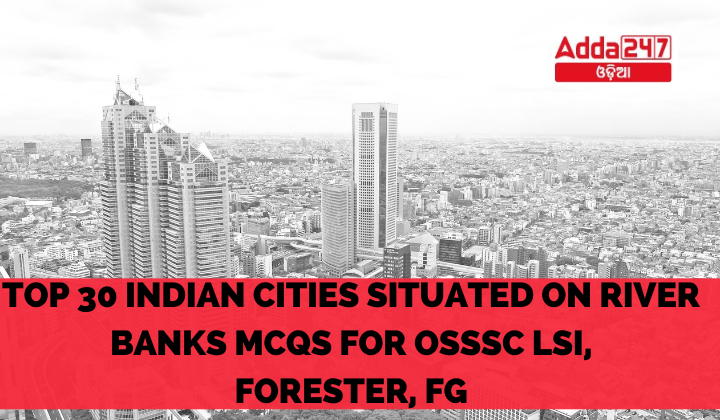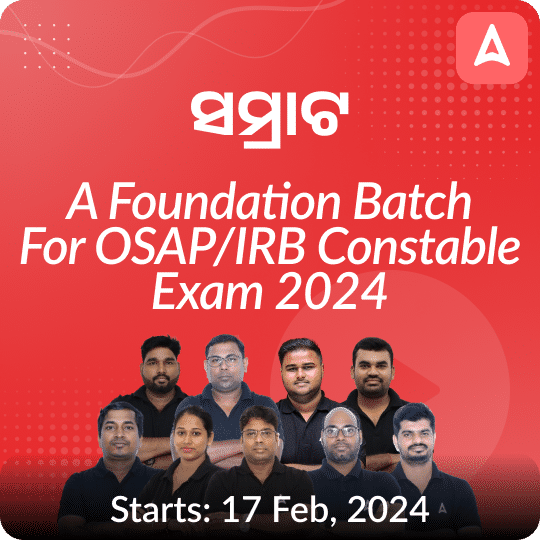India, a land blessed with numerous rivers, has many cities thriving along their banks. Understanding the geographical and cultural significance of these cities is essential for various competitive exams like the OSSSC LSI, Forester, and FG. Let’s delve into a set of multiple-choice questions (MCQs) focused on the top 30 Indian cities situated on river banks.
Top 30 Indian Cities Situated on River Banks MCQs for OSSSC LSI, Forester, FG
Understanding the geographical locations of Indian cities situated along river banks is not only crucial for competitive exams but also enriches our knowledge of India’s cultural and historical significance. These MCQs provide a comprehensive overview of some of the most prominent cities in India and the rivers that flow through them.
- The river known as “The River of Sorrow,” which rises in the Kamarpet hill in Chhotanagpur Plateau of Bihar, is:
A. Mahanadi
B. Damodar
C. Krishna
D. Godavari
Answer: Option B
Explanation: The Damodar River, earlier called the “River of Sorrows,” originates in the Kamarpet hill in Chhotanagpur Plateau of Bihar. It used to flood many areas of Bardhaman, Hooghly, Howrah, and Medinipur districts. Though the lower Damodar Valley still faces occasional floods, the severity witnessed in the past is now part of history. - Arrange the following rivers of India in descending order of length:
A. Brahmaputra, Ganga, Godavari, Kosi
B. Ganga, Brahmaputra, Krishna, Godavari
C. Ganga, Godavari, Yamuna, Krishna
D. Ganga, Yamuna, Godavari, Mahanadi
Answer: Option C
Explanation: The correct descending order of the rivers of India by length is Ganga, Godavari, Yamuna, and Krishna. - Sequence the following rivers in India from north to south:
A. Shyok – Spiti – Zaskar – Sutlej
B. Shyok – Zaskar – Spiti – Sutlej
C. Zaskar – Shyok – Sutlej – Spiti
D. Zaskar – Sutlej – Shyok – Spiti
Answer: Option C
Explanation: The correct sequence of these rivers in India from north to south is Zaskar – Shyok – Sutlej – Spiti. - Match the following tributaries with their main rivers:
a. Chambal – Narmada
b. Son – Yamuna
c. Manas – Brahmaputra
Which pairs are correctly matched?
A. a, b, and c
B. a and b only
C. a and c only
D. c only - Answer: Option D
Explanation: The correct matches are: Chambal – Yamuna
Son – Ganga
Manas – Brahmaputra - Identify the trans-Himalayan river from the following options:
A. Ganga
B. Yamuna
C. Sutlej
D. Ravi
Answer: Option C
Explanation: The Sutlej is a trans-Himalayan river, originating beyond the Great Himalayas. - Alamatti is located along which river?
A. Godavari
B. Cauvery
C. Krishna
D. Mahanadi
Answer: Option C
Explanation: Alamatti is situated on the Krishna River, and the reservoir built across it has reached its maximum level due to heavy rainfall in Maharashtra. - Which two Peninsular rivers do not join the Arabian Sea?
A. Narmada and Tapi
B. Narmada and Cauvery
C. Godavari and Krishna
D. Tapi and Cauvery
Answer: Option A
Explanation: Narmada and Tapi are the two Peninsular rivers that do not join the Arabian Sea. - Which port is classified as an inland riverine port?
A. Kolkata
B. Mumbai
C. Chennai
D. Tuticorin
Answer: Option A
Explanation: Kolkata is situated along the Hoogly river and is classified as an inland riverine port. - What is the main river flowing in the state of Jammu and Kashmir?
A. Jhelum
B. Indus
C. Chenab
D. Nubra
Answer: Option A
Explanation: The Jhelum River is the primary river flowing through the Kashmir valley in the state of Jammu and Kashmir. - Which river is referred to as ‘Vridha Ganga’?
A. Godavari
B. Krishna
C. Mahanadi
D. Cauvery
Answer: Option A
Explanation: The Godavari river is called ‘Vridha Ganga’ due to its large size and extensive reach among the peninsular rivers. - Which city is not situated on a river bank?
A. Surat
B. Agra
C. Cuttack
D. Mysore
Answer: Option D - Arrange the following rivers in descending order of their total basin area:
A. Ganga Indus Brahmaputra Godavari
B. Indus Ganga Brahmaputra Godavari
C. Brahmaputra Indus Ganga Godavari
D. Indus Ganga Godavari Brahmaputra
Answer: Option C
Explanation: The correct sequence of rivers in terms of their total basin area, in descending order, is Brahmaputra, Indus, Ganga, and Godavari. - The Buckingham Canal traverses through:
A. Tamil Nadu and Karnataka
B. Kerala and Andhra Pradesh
C. Tamil Nadu and Kerala
D. Andhra Pradesh and Tamil Nadu
Answer: Option D
Explanation: The Buckingham Canal runs through Andhra Pradesh and Tamil Nadu, extending from Kakinada in Andhra Pradesh to Villupuram District in Tamil Nadu. - Identify the largest irrigation canal in India:
A. Yamuna canal
B. Indira Gandhi canal
C. Sirhand canal
D. Upper Bari Doab canal
Answer: Option B
Explanation: The largest canal project in India is the Indira Gandhi canal, primarily supplying water to Rajasthan. - Prior to entering India, the river Tsangpo flows through which region?
A. Myanmar
B. Pakistan
C. Tibet
D. China
Answer: Option C
Explanation: The river Tsangpo flows through Tibet before entering India, specifically Arunachal Pradesh. - Match the following projects with their respective states:
A. Tulbul Project – Himachal Pradesh
B. Srisailam Project – Tamil Nadu
C. Papanasam Project – Karnataka
D. Ukai Project – Gujarat
Answer: Option D
Explanation: Correct match: Ukai Project – Gujarat; Tulbul – J & K; Srisailam – Andhra Pradesh; Papanasam – Tamil Nadu - The Buckingham Canal serves as an inland waterway in which country?
A. United Kingdom
B. Australia
C. India
D. New Zealand
Answer: Option C
Explanation: The Buckingham Canal is an inland waterway in India, stretching along the Coromandel Coast. - Through which state does the Tibetan river ‘Tsangpo’ enter India?
A. Arunachal Pradesh
B. Assam
C. Manipur
D. Nagaland
Answer: Option A
Explanation: The Tibetan river ‘Tsangpo’ enters India through the state of Arunachal Pradesh, where it is known as Siang. - Which river demarcates the ‘Deccan Tableland’ from Central Highland in northern India?
A. Chambal
B. Krishna
C. Godavari
D. Narmada
Answer: Option D
Explanation: The Narmada River divides the Deccan Plateau from the Central Highlands in northern India. - Identify the incorrectly matched pair of sea ports and states:
A. Kandla : Gujarat
B. Paradip : Orissa
C. Quilon : Kerala
D. Kakinada : Maharashtra
Answer: Option D
Explanation: Kakinada Port is located in Andhra Pradesh, not Maharashtra. - Which river is known as India’s River of Sorrow?
A. Hooghly
B. Damodar
C. Ghaghara
D. Kosi
Answer: Option D
Explanation: The Kosi River in Bihar and Jharkhand is known as the “Sorrow of Bihar” or “River of Sorrow” in India. - Where does the River Indus originate from?
A. Hindukush range
B. Himalayan range
C. Karakoram range
D. Kailash range
Answer: Option D
Explanation: The Indus is a 3,200km long trans Himalayan river. It rises from Sengge Zangbo glacier in southwest Tibet near Lake Manasarovar in the Kailash range. - Which of the following peninsular rivers flows westward?
A. Mahanadi
B. Godavari
C. Tapti
D. Cauvery
Answer: Option C
Explanation: The Tapti peninsular river flows westward. It flows through rift valleys with a different gradient. - Where does the river Cauvery flow from?
A. Andhra Pradesh to Tamil Nadu
B. Karnataka to Maharashtra
C. Karnataka to Tamil Nadu
D. Kerala to Tamil Nadu
Answer: Option C
Explanation: The river Cauvery flows from Karnataka to Tamil Nadu. It originates at Talakaveri in the Western Ghats and flows southeast across Karnataka and Tamil Nadu. - What is the fertile land between two rivers called?
A. Drainage basin
B. Watershed
C. Doab
D. Lowland or terrain
Answer: Option C
Explanation: Doab is the tract of land lying between two conflating rivers. Punjab is an example, lying between five rivers. - Which major river system does Teesta form a part of?
A. Ganga
B. Krishna
C. Cauvery
D. Brahmaputra
Answer: Option D
Explanation: Teesta forms a part of the Brahmaputra river system. It joins the Brahmaputra in Bangladesh. - Why do most rivers flowing westward from the Western Ghats not form deltas?
A. Because of the high gradient
B. They are too slow
C. They are not perennial
D. There is no vegetation
Answer: Option A
Explanation: Most rivers flowing westward from the Western Ghats do not form deltas due to the high gradient. - Which states does the Krishna river flow through?
A. Karnataka, Andhra Pradesh
B. Maharashtra, Madhya Pradesh
C. Maharashtra, Andhra Pradesh
D. Maharashtra, Karnataka
Answer: Option D
Explanation: The Krishna river flows through Maharashtra and Karnataka before reaching Telangana and Andhra Pradesh. - What is the Brahmaputra known as when it enters Arunachal Pradesh?
A. Dibang
B. Dihang
C. Subansiri
D. Dhansiri
Answer: Option B
Explanation: The Brahmaputra is known as the Dihang as it enters Arunachal Pradesh. - Which two west flowing rivers are situated between the Satpura range?
A. Narmada and Luni
B. Narmada and Tapi
C. Tapi and Mahi
D. Mahi and Luni
Answer: Option B
Explanation: The Satpura range is situated between the Narmada and Tapi rivers, both of which flow westward.










